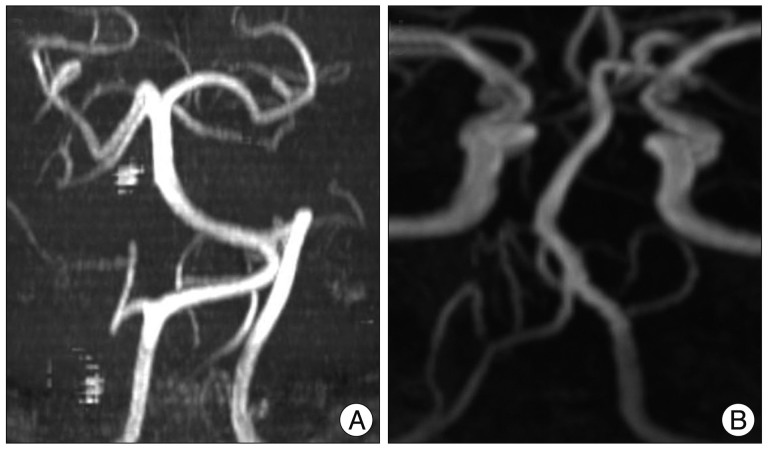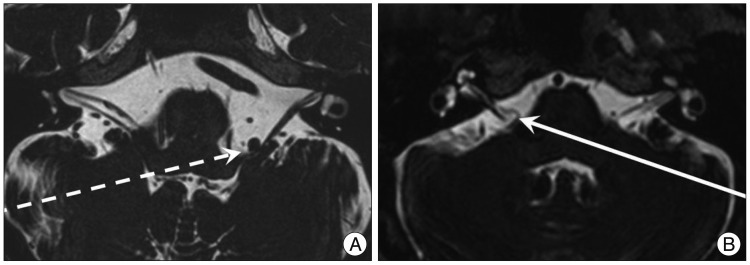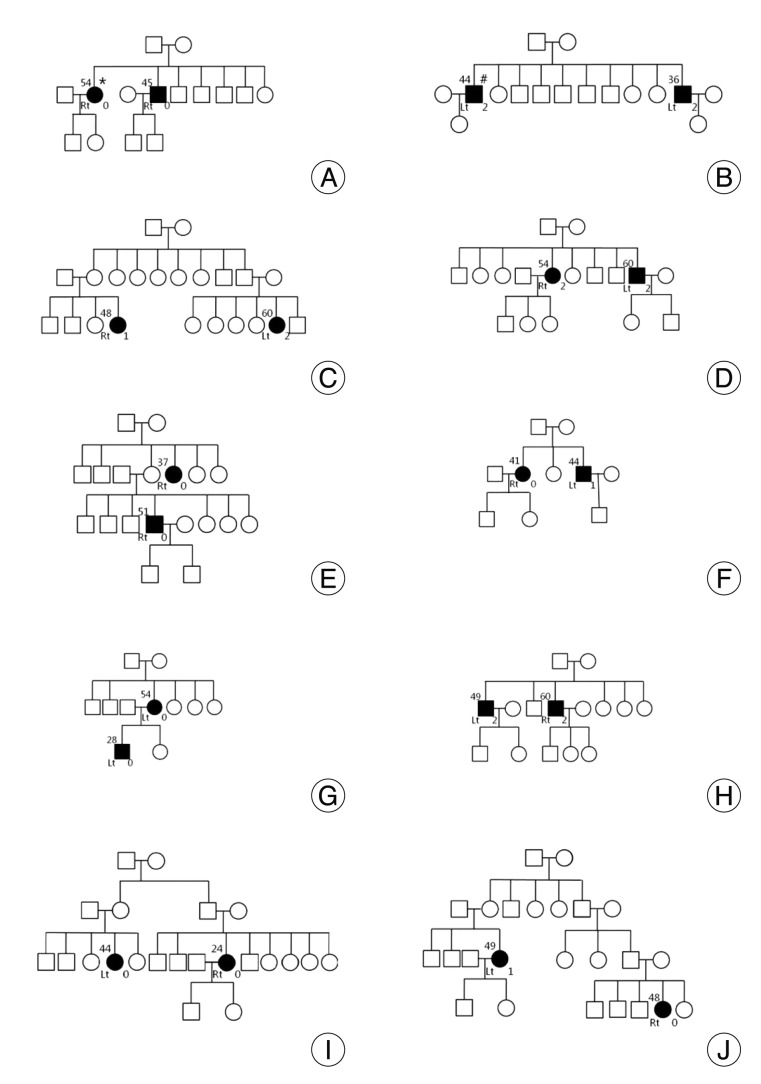J Korean Neurosurg Soc.
2013 Jan;53(1):1-5. 10.3340/jkns.2013.53.1.1.
Microvascular Decompression for Familial Hemifacial Spasm : Single Institute Experience
- Affiliations
-
- 1Department of Neurosurgery, Samsung Medical Center, Sungkyunkwan University School of Medicine, Seoul, Korea. kwanpark@skku.edu
- KMID: 2066977
- DOI: http://doi.org/10.3340/jkns.2013.53.1.1
Abstract
OBJECTIVE
The purpose of this study was to evaluate the characteristics and surgical outcomes of familial hemifacial spasm (HFS) and to discuss the role of genetic susceptibility.
METHODS
Between 2001 and 2011, 20 familial HFS patients with ten different pedigrees visited our hospital. The data from comprehensive evaluation of these patients, including clinical, radiological and electrophysiological data and surgical outcomes were reviewed to characterize familial HFS and to compare the characteristics between familial HFS and sporadic HFS.
RESULTS
According to the family tree, the inheritance pattern was difficult to define clearly using these data. Radiologic findings suggested that the vertebral artery (VA) was a more frequent offender in familial HFS than in sporadic cases (35.0% vs. 10.0%, p<0.001). Chi-square test showed that there were no correlation between VA tortuosity and underlying morbidity such as diabetes or hypertension (p=0.391). Eighteen out of 19 patients who underwent microvascular decompression showed no residual spasm. Other features of familial HFS overlap with sporadic cases. These findings suggest that certain genetic susceptibilities rather than hypertension or diabetes may influence vascular tortuosity and HFS development.
CONCLUSION
In this study, familial HFS seems not so different from sporadic cases. Authors thought familial HFS could have heterogeneous etiology. Further study of familial HFS including clinical, anatomic, genetic, and molecular information may help identify a gene or trait that can provide insight into the mechanisms of sporadic and familial HFS.
MeSH Terms
Figure
Reference
-
1. Barbosa ER, da Costa Mdo D, Staut CC, Bacheschi LA, Bittar MS. [Familial hemifacial spasm : report of 2 cases]. Arq Neuropsiquiatr. 1998; 56:111–115. PMID: 9686130.2. Barker FG 2nd, Jannetta PJ, Bissonette DJ, Shields PT, Larkins MV, Jho HD. Microvascular decompression for hemifacial spasm. J Neurosurg. 1995; 82:201–210. PMID: 7815147.
Article3. Carter JB, Patrinely JR, Jankovic J, McCrary JA 3rd, Boniuk M. Familial hemifacial spasm. Arch Ophthalmol. 1990; 108:249–250. PMID: 2302111.
Article4. Coad JE, Wirtschafter JD, Haines SJ, Heros RC, Perrone T. Familial hemifacial spasm associated with arterial compression of the facial nerve. Case report. J Neurosurg. 1991; 74:290–296. PMID: 1988602.
Article5. Colosimo C, Chianese M, Romano S, Vanacore N. Is hypertension associated with hemifacial spasm? Neurology. 2003; 61:587. author reply 587. PMID: 12939456.
Article6. Friedman A, Jamrozik Z, Bojakowski J. Familial hemifacial spasm. Mov Disord. 1989; 4:213–218. PMID: 2779592.
Article7. Han IB, Kim NK, Huh R, Shin DA, Moon JY, Park HM, et al. The role of genetic factors in the development of hemifacial spasm : preliminary results. Acta Neurochir Suppl. 2008; 101:107–110. PMID: 18642643.8. Hyun SJ, Kong DS, Park K. Microvascular decompression for treating hemifacial spasm : lessons learned from a prospective study of 1,174 operations. Neurosurg Rev. 2010; 33:325–334. discussion 334. PMID: 20349099.
Article9. Jannetta PJ. The cause of hemifacial spasm : definitive microsurgical treatment at the brainstem in 31 patients. Trans Sect Otolaryngol Am Acad Ophthalmol Otolaryngol. 1975; 80:319–322.10. Jannetta PJ, Abbasy M, Maroon JC, Ramos FM, Albin MS. Etiology and definitive microsurgical treatment of hemifacial spasm. Operative techniques and results in 47 patients. J Neurosurg. 1977; 47:321–328. PMID: 894338.11. Jeon CJ, Kong DS, Lee JA, Park K. The efficacy and safety of microvascular decompression for hemifacial spasm in elderly patients. J Korean Neurosurg Soc. 2010; 47:442–445. PMID: 20617090.
Article12. Jo KW, Kim JW, Kong DS, Hong SH, Park K. The patterns and risk factors of hearing loss following microvascular decompression for hemifacial spasm. Acta Neurochir (Wien). 2011; 153:1023–1030. PMID: 21240531.
Article13. Lagalla G, Logullo F, Di Bella P, Haghighipour R, Provinciali L. Familial hemifacial spasm and determinants of late onset. Neurol Sci. 2010; 31:17–22. PMID: 19812891.
Article14. Lang J. Clinical anatomy of the head : neurocranium, orbit, craniocervical regions. 1983. Berlin: Springer;p. 329–333.15. Micheli F, Scorticati MC, Gatto E, Cersosimo G, Adi J. Familial hemifacial spasm. Mov Disord. 1994; 9:330–332. PMID: 8041374.
Article16. Miwa H, Mizuno Y, Kondo T. Familial hemifacial spasm : report of cases and review of literature. J Neurol Sci. 2002; 193:97–102. PMID: 11790389.17. Møller AR, Jannetta PJ. Hemifacial spasm: results of electrophysiologic recording during microvascular decompression operations. Neurology. 1985; 35:969–974. PMID: 4010963.
Article18. Møller AR, Jannetta PJ. Microvascular decompression in hemifacial spasm : intraoperative electrophysiological observations. Neurosurgery. 1985; 16:612–618. PMID: 4000433.
Article19. Nielsen VK. Electrophysiology of the facial nerve in hemifacial spasm : ectopic/ephaptic excitation. Muscle Nerve. 1985; 8:545–555. PMID: 2995804.
Article20. Rahman EA, Trobe JD, Gebarski SS. Hemifacial spasm caused by vertebral artery dolichoectasia. Am J Ophthalmol. 2002; 133:854–856. PMID: 12036693.
Article21. Wang A, Jankovic J. Hemifacial spasm : clinical findings and treatment. Muscle Nerve. 1998; 21:1740–1747. PMID: 9843077.
- Full Text Links
- Actions
-
Cited
- CITED
-
- Close
- Share
- Similar articles
-
- Intraoperative monitoring of microvascular decompression in hemifacial spasm
- Microvascular triple decompression for combined simultaneous trigeminal neuralgia, hemifacial spasm, and pulsatile tinnitus due to separate offending vessels
- Delayed Unilateral Soft Palate Palsy without Vocal Cord Involvement after Microvascular Decompression for Hemifacial Spasm
- Efficacy of Intraoperative Facial Electromyographic Monitoring in Patients with Hemifacial Spasm
- Intraoperative Facial EMG Monitoring during Decompression Operation for Hemifacial Spasm




